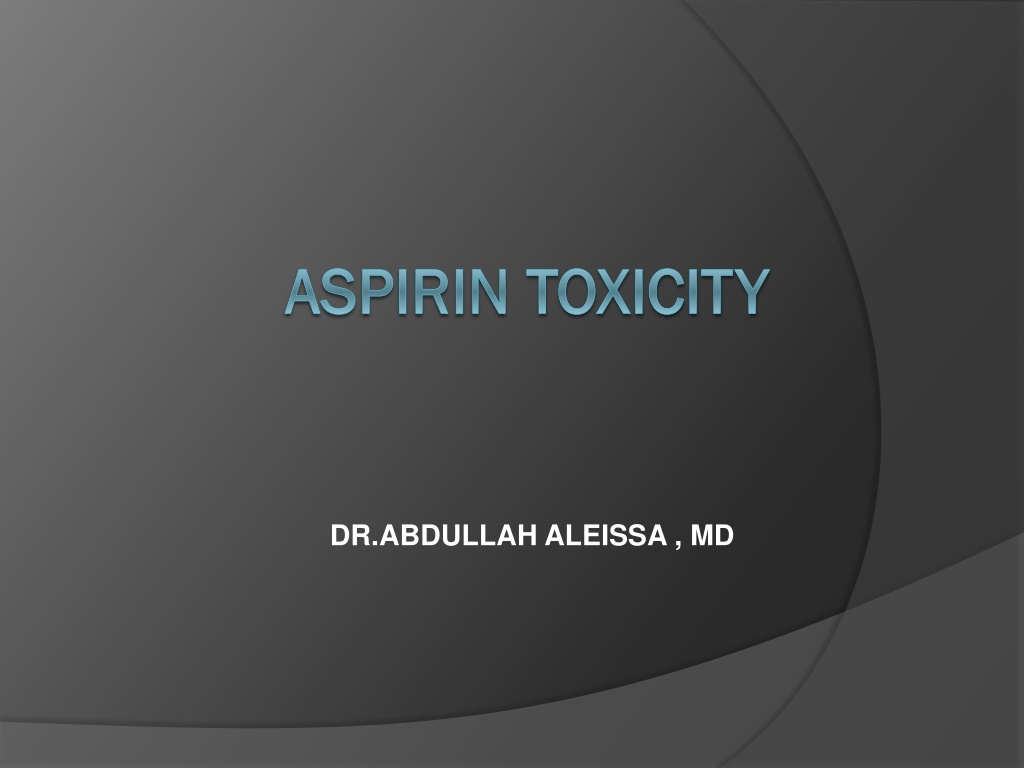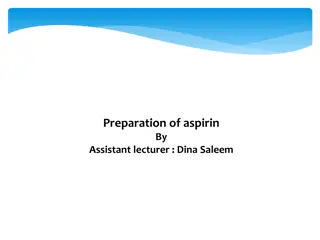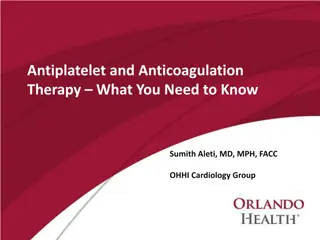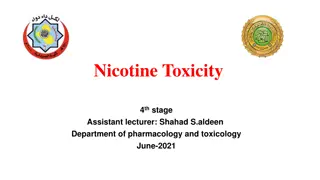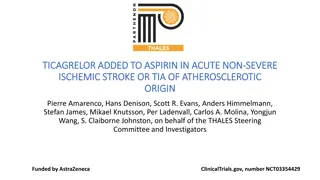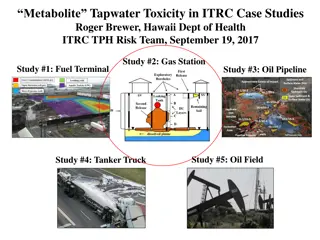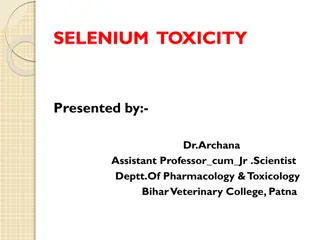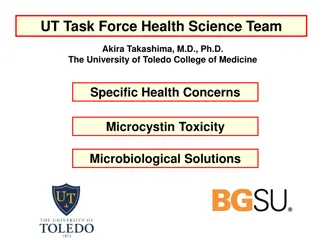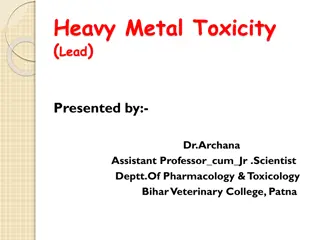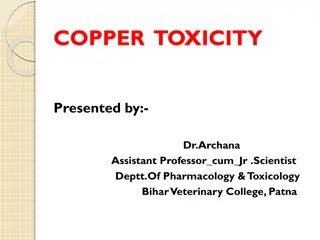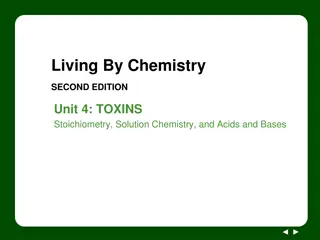Understanding Aspirin Toxicity: Overview and Management
Aspirin toxicity, though decreasing in incidence, can still result in severe consequences such as metabolic acidosis, seizure, and even death. This condition is often underestimated due to lack of familiarity with its clinical presentation. Treatment focuses on maintaining salicylate in the ionized form to prevent toxicity, especially in cases of chronic ingestion seen in the elderly. Pharmacokinetics and pathophysiology further elucidate the mechanisms of aspirin toxicity, emphasizing the importance of prompt recognition and management.
Download Presentation

Please find below an Image/Link to download the presentation.
The content on the website is provided AS IS for your information and personal use only. It may not be sold, licensed, or shared on other websites without obtaining consent from the author. Download presentation by click this link. If you encounter any issues during the download, it is possible that the publisher has removed the file from their server.
E N D
Presentation Transcript
ASPIRIN TOXICITY ASPIRIN TOXICITY DR.ABDULLAH ALEISSA , MD
Perspective Perspective The incidence of aspirin (acetylsalicylic acid [ASA]) overdose and related childhood deaths has decreased significantly in recent years. Reasons include pediatricians preference for acetaminophen preparations, the Food and Drug Administration s mandate limiting 36 tablets of baby aspirin to each bottle, and the use of child-resistant caps.
Unfortunately, the severity of this poisoning may be underestimated because of the lack of familiarity with the clinical picture. Salicylate toxicity can cause metabolic acidosis, seizure, hyperthermia, pulmonary edema, cerebral edema, renal failure, and death.
Principles of Disease Principles of Disease Salicylic acid is a weak acid that at normal serum pH is mostly ionized, therefore will not cross the blood-brain barrier or the renal tubules (for reabsorption). As the blood becomes more acidemic, a more nonionized form develops, allowing salicylate to enter the brain and be reabsorbed by the kidneys (decreasing renal excretion).
Treatment is logically geared toward keeping salicylate in the ionized form. Chronic excessive use of salicylates (chronic ingestion) is seen primarily in the elderly and is associated with a higher clinical toxicity for a given serum salicylate level.
Pharmacokinetics Salts of salicylic acid are rapidly absorbed intact from the gastrointestinal tract, with appreciable serum concentrations occurring within 30 minutes. Two thirds of a therapeutic dose is absorbed in 1 hour, and peak levels occur in 2 to 4 hours. Large ingestions frequently delay gastric emptying, and ingestions of enteric capsules may cause a prolonged absorption with rising serum levels for 12 hours or more.
Pathophysiology Direct stimulation of respiratory center hyperventilation and respiratory alkalosis. Stimulation of chemoreceptor trigger zone vomiting. Uncoupling of oxidative phosphorylation anaerobic metabolism, lacate production, anion- gap acidosis, and hyperthermia.
Increased fatty acid metabolism metabolic acidosis (ketones) Ototoxicity tinnitus and hearing loss correlate with salicylate level. Platelets permanently lose their ability to aggregate at therapeutic aspirin doses. Bleeding is rare in overdose. Cerebral and pulmonary edema secondary to alterations in capillary integrity.
Clinical Features Clinical Features Acute ingestion : Early symptoms include N/V, tinnitus, hearing loss, lethargy, hyperventilation, and hyperthermia. The classic presentation of mild to moderate toxicity is a mixed acid- base picture with a respiratory alkalosis, wide anion-gap metabolic acidosis, and (possibly) a metabolic alkalosis (from dehydration). Blood gases early on often show a respiratory alkalosis with pH > 7.5. Less respiratory alkalosis (and therefore greater overall acidosis) is seen in children.
Severe intoxication results in profound metabolic acidosis, marked hyperthermia, cerebral edema (coma and seizure), hypoglycemia, pulmonary edema, cardiovascular collapse. So , patient with respiratory alkalosis and increased anion-gap metabolic acidosis? Think salicylate toxicity.
Chronic ingestion : Symptoms of toxicity overlap with those of acute ingestion, but are slower in onset and often nonspecific. Patients often present with confusion, dehydration, and metabolic acidosis. Neurologic symptoms are common, including confusion, hallucinations, agitation, coma. Pulmonary edema, cerebral edema, seizures, and renal failure occur more frequently compared to acute ingestions.
Diagnostic Strategies Diagnostic Strategies Based on history, physical examination, and acid-base findings. A toxic dose of aspirin is 200 to 300 mg/kg, and ingestion of 500 mg/kg is potentially lethal. Maintain high level of suspicion in patients with: Unexplained respiratory alkalosis Mixed metabolic disorders Metabolic acidosis Elderly with altered mental status Patients with hearing complaints Key labs: Salicylate level, ABG, electrolytes
Initial Evaluation After the primary survey, a general physical examination is conducted to assess vital signs (including oxyhemoglobin saturation and a counted respiratory rate and reliable temperature). Chest auscultation may provide evidence of pulmonary edema, and mental status may suggest CNS toxicity.
Early arterial blood gas determinations in symptomatic patients rapidly assess acid-base and compensatory status. A serum salicylate concentration should be measured with a second sample obtained 2 hours later. If the second concentration is greater than the first, serial concentrations should be obtained to monitor continued absorption, which may be prolonged.
Urine ferric chloride test will confirm exposure, but not toxicity. The Done nomogram should NOT be used as salicylate toxicity correlates poorly with serum concentrations.
Management Management Specific treatment of salicylate toxicity has two main objectives: (1) to correct fluid deficits and acid-base abnormalities. (2) Increase excretion.
Supportive and symptomatic care : Avoid CNS/respiratory depressants, which may decrease the respiratory alkalosis and thereby worsen the acidemia. If intubated, match the preintubation Pco2. IV hydration (not forced diuresis) to maintain renal perfusion.
Sodium bicarbonate therapy: 1 2 mEq/kg IV bolus, followed by drip. Goal is urinary alkalinization to pH 7.5 8.0. Correct hypokalemia: Results from intracellular shifts and body losses. Urinary alkalinization will not occur unless hypokalemia is corrected. Obtain basic metabolic panel and salicylate levels every 2 hours. Monitor salicylate levels until levels have declined to near therapeutic concentration.
Hemodialysis is indicated for patients with the following: Level > 100 mg/dL (acute ingestions), Level > 40 mg/dL (chronic ingestions) accompanied by clinical signs of severe intoxication. Altered mental status. Renal failure/anuria. Severe persistent acid-base disturbance. Pulmonary edema. Failure to respond to intensive treatment. 1) 2) 3) 4) 5) 6)
